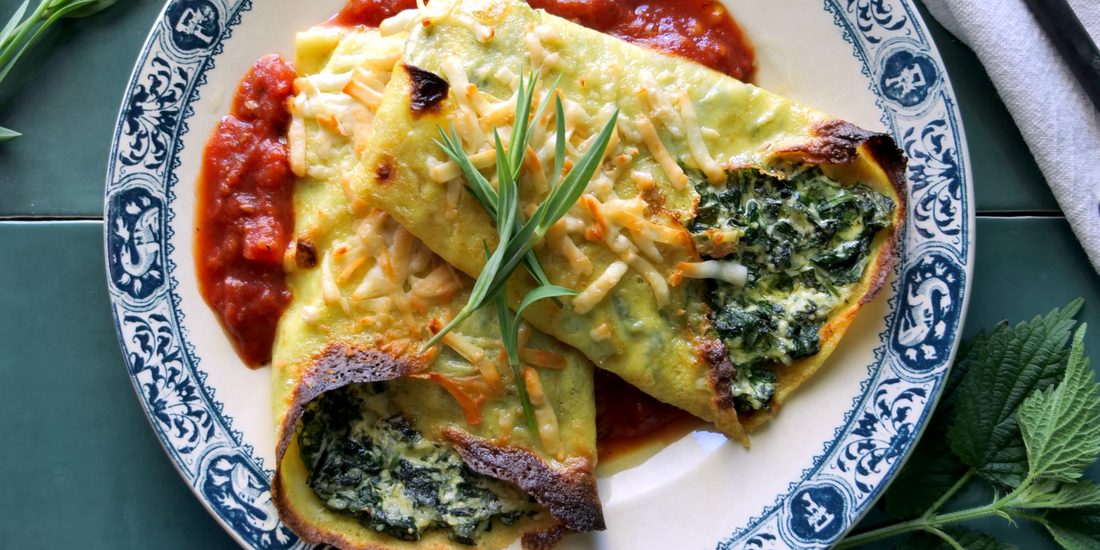
Crespelle with Stridolo, Nettles, Spinach & Ricotta
Share
Crespelle are the Italian version of French crêpes. Crespelle is the plural while crespella is the singular. Crespella and crêpe batter are pretty much the same, although the type of flour can differ. French crêpes are sometimes made with buckwheat flour while Italian crespelle are sometimes made with chestnut flour. Otherwise, wheat flour is the go-to for both crespelle and crêpes. Which one came first: crêpes or crespelle? That’s a debatable culinary origin story. It’s said that crespelle originated in Tuscany and was brought to Paris via the Italian noblewoman and eventual Queen of France, Catherine de’Medici. No matter the genesis, this thin pancake is undoubtedly beloved worldwide.
It’s interesting to note how Italian cuisine uses crespelle as an alternative to pasta. In this way, crespelle can be shaped and filled in all manner of ways - ribboned like tagliatelle, rolled like cannelloni, or layered like lasagna. Crespelle alla Fiorentina is a traditional Florentine dish that fills crespelle with ricotta and spinach. It is often served with tomato sauce and/or béchamel. This is the dish that has inspired my recipe below. I’ve long needed a vehicle in which to highlight the stridolo and nettles growing in my garden. This seemed like a tasty and fairly authentic place to start.

Stridolo [Silene vulgaris (syn. Silene inflata)] is a lovely plant with glaucous leaves and balloon-like flowers. I am in awe every time I catch a glimpse of those puffy, frilly blossoms. They float on the air like little lanterns, seemingly lit from within when the sunset hits just right. These flowers are edible, but it’s the leaves which are usually the star of the kitchen. “Stridolo” is the Italian name for this plant. It is also known as bladder campion, sculpit, and collejas (Spanish). Another Italian name is the very similar sounding “strigolo”.
Stridolo grows wildly in all of the Mediterranean and Eurasia at large. It seems to have had a greater impact on Spanish, Italian, and Greek foodways. I’ve decided to experiment with Silene vulgaris from the Italian perspective, hence this Italian recipe and my use of the term “stridolo”. Yet a trip to any of the Mediterranean countries would inform a breadth of knowledge on this plant and its uses. While we Americans know very little of Silene vulgaris, the plant has naturalized in many parts of the U.S. You might have some growing near you! I, unfortunately, have not found this plant growing wildly near me. And so, I’ve had to grow it in my garden. Perhaps that’s for the best because I have a sneaking suspicion that the cultivated form is more robust and tastier than the wild form. I encourage you to plant some in your garden if you don’t have access to it either. It is edible, gorgeous when in flower, and perennial. I haven’t found the cultivated form to be aggressive or weedy.

So what does stridolo taste like?? It’s more of a green vegetable than an herb. In my singular experience, the raw young leaves that emerge in spring taste sweet like green peas. That sweetness quickly goes bitter as the weather warms up. The good news is that cooking removes that bitter quality and leaves you with a mild flavor similar to spinach. I’d still recommend harvesting in spring/early summer for optimal flavor. There’s a mucilaginous quality to the cooked leaves. To me that screams healthy! It’s true that eating stridolo and/or nettles will have compounding nutritional benefits than eating spinach alone. The sliminess of cooked stridolo and the hairiness of nettle is undetectable in this recipe, so no fear if you don’t like those textures.

While you can certainly omit the stridolo and nettles from this recipe and replace them with spinach only, it seems extra special to make an Italian dish using wild greens that grow in Italy and are used in Italian kitchens. You might live in an area where you can forage for both Silene vulgaris and nettles (Urtica dioica), too! That’s the beauty of these circumglobal wild edibles. Or perhaps you’re like me and have to cultivate what is wild for others. That’s wonderful too! No matter if you’re in wild nature or in the cultivated garden, I hope you feel like an Italian nonna. You’ll need to embody her fortitude because this recipe is quite intensive!
Crespelle with Stridolo, Nettles, Spinach & Ricotta
INGREDIENTS
-
STRIDOLO, NETTLE, SPINACH & RICOTTA FILLING:
- 75g stridolo, leaves & supple tips
- 40g nettles, leaves & supple tips (handle with rubber gloves)
- 200g fresh spinach
- 1 egg
- 1 pound ricotta
- 1 cup pecorino romano, shredded
- Whole nutmeg to taste
- 1 garlic clove
- Black pepper to taste
-
CRESPELLE:
- 1½ cups milk
- 4 eggs
- ½ teaspoon sea salt
- 1 cup (4 oz.) all-purpose flour
- 4 tablespoons unsalted butter, melted
- Oil, as needed
-
TO FINISH:
- 1 cup pecorino romano, shredded
- 2 cups prepared tomato sauce
INSTRUCTIONS
To make the stridolo, nettle, spinach, and ricotta filling:
- Bring a large kettle of water to boiling.
- Meanwhile, add the stridolo, nettles, and spinach to a large bowl. (Wear rubber gloves when handling uncooked nettles)
- Run cold water over the greens until submerged. Use tongs or gloved hands to swish the water, loosening any debris and/or bugs. Drain the water using a colander. Repeat rinsing and draining until the water is clean. This cleaning step is helpful for foraged or garden fresh greens.
- Return the cleaned greens to the large bowl. To blanch, pour the kettle of boiling water over the greens until they are submerged, stirring with tongs as needed. Cook for only 1 minute. Then, carefully drain off the water in a colander and immediately run cold water over the greens to stop the cooking process. (At this point, the nettles should be safe to handle without gloves)
- Use your hands to ball up the greens and wring out as much liquid as possible.
- Chop the greens into small pieces. Set aside.
- Crack 1 egg into a mixing bowl. Whisk.
- Add the ricotta and grated pecorino romano.
- Add a few scrapes of whole nutmeg using a microplane or other fine grater. Then grate the garlic clove and add it to the bowl.
- Add black pepper to taste. (The pecorino offers a lot of saltiness, but you can add more salt if desired)
- Add the chopped greens. Mix everything together until well combined. Refrigerate this filling until ready to use.
To make the crespelle:
- In a mixing bowl, whisk together the milk, eggs, and salt.
- Working in stages, sift in the flour and whisk to create a smooth batter. Mix in the melted butter.
- Refrigerate the crespelle batter for at least 2 hours (up to 24 hours).
- When ready to make the crespelle, heat an 8-inch non-stick pan or griddle to 300F. Use oil to lightly grease the pan/griddle if necessary. Carefully wipe away excess oil with a paper towel. Have a long, flexible spatula and a large plate on standby.
- Mix the crespelle batter well. Then pour ¼ cup of batter onto the hot surface. Quickly rotate the pan (or use a crêpe stick on a griddle) to spread the batter in a thin, even layer. Cook for 2-3 minutes until color starts to develop.
- Flip the crespella with a spatula and cook for 30-60 seconds.
- When the crespella looks done, gently remove it and place it on a plate.
- Repeat this process with the remaining batter, using oil between batches if necessary. Stack the crespelle on top of one another. You will want 8 crespelle for the final recipe. The batter should make more than 8 crespelle, so you will have a few attempts to get things right. A little grace is always needed when making crespelle or crêpes!
To assemble the dish:
- Preheat the oven to 400F.
- Take the filling and roughly divide it into 8 portions.
- Lay out the crespelle and spread a portion of filling in the middle of each one.
- For each crespella, make 2 folds over the filling then tuck the small end underneath.
- Place the crespelle in a single layer on a baking sheet lined with parchment paper. Sprinkle 1 cup of grated pecorino romano over top of the crespelle.
- Bake for 15-20 minutes or until the cheese has melted and the edges are brown.
- While the crespelle are baking, heat 2 cups of prepared tomato sauce. Keep it warm for serving.
- Once the crespelle are out of the oven, spoon warm tomato sauce on plates and lay the crespelle on top to serve.
